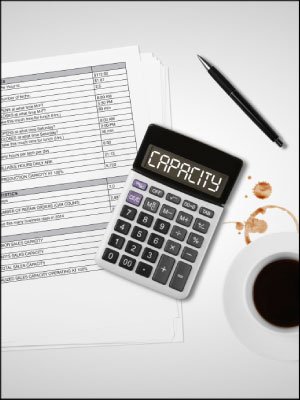From Ratchet+Wrench, December 2014
Maximize your shop’s throughput with simple calculations

Knowing your shop’s capacity, both in terms of sales and production, is key to avoiding bottlenecks and maximizing the number of jobs that can be completed profitably each day. By understanding their shop’s production capacity, owners can work to fix process flaws and maximize sales.
Scott Wheeler, owner of Automotive Business Consultants Group, regularly helps shops find their maximum throughput. Wheeler discusses how to calculate your shop capacity and the various factors that need to be considered.
It’s important to know your shop’s potential capacity so you can set benchmarks. If you don’t know what 100 percent production capacity would be, then how will you ever know if you’re hitting the mark or not? To do that, you need to understand the capabilities of the physical layout of the shop.
Hourly labor rate x billable daily hours = daily labor sales capacity
Daily labor sales capacity = Daily parts sales capacity (Wheeler says this figure is the same because for every dollar you bring in parts, you should be bringing in a dollar in labor)
Daily labor sales capacity + daily parts sales capacity = Daily total sales capacity
Daily total sales capacity x available annual work days = Annualized sales capacity operating at 100 percent
I have created several formulas that, together, paint a picture of total shop capacity. To start, you will need your labor statistics: hourly labor rate, number of techs, the number of hours your shop is open and the number of days you are open in a year.
First, you will figure out your billable daily hours. To do that, multiply the number of technicians you have by the number of billable hours per technician per day. That total is the number of hours you could be billing in a day.
To figure that out for the whole year, multiply the total billable daily hours by the number of available business days. With that total, you can compare your total billable labor hours from last year.
Next, we take a look at the shop statistics. The three pieces of information you will need are the number of bays in your shop, the annual number of repair orders (yearly car count), and the available business days. You will use that information to figure out your daily sales capacity and net income.
In terms of sales capacity, I look at daily labor, parts and total sales capacity, and then I also look at the annualized sales capacity for a shop operating at 100 percent. The annualized sales capacity will show you, in a perfect world, what you could be bringing in if you billed every hour that the technician is on the shop floor.
Then I look at gross profit margin. First, I look at current gross profit margin, which you can pull from your profit and loss statement. To find the gross profit dollar potential operating at 100 percent, simply multiply your current gross profit margin by the annualized sales capacity operating at 100 percent.
Then take that total and subtract your less current total operating expenses (which can be found on your profit and loss statement) to calculate your total net income realized. This figure will show you what your net income could be at full capacity.
What you should do next is compare your gross profit dollars and your net income from last year to these totals. That’s going to point very clearly to specific operational deficiencies, if they exist. The goal is then to dig in and find out what’s causing the problem.
The final piece of the puzzle is your effective labor rate, which is a calculation showing the efficiency ratio of actual sales to total sales potential. The calculation for effective labor rate is simply total yearly labor sales divided by annual available billable labor hours.
The reason effective labor rate is important is because many people want to raise their labor rates. But if you’re less than 90 percent effective, you’re going to lose a certain amount for every hour you bill out, even if you raise your labor rate. You should first try to dig into your processes and try to raise your effective labor rate first.
I do this exercise with every single client. These calculations demonstrate where inefficiencies exist or if the shop is maxed out. It will immediately tell you what you have to work on to get the most out of your staff and your space.
